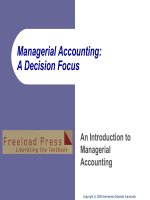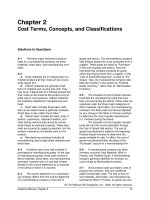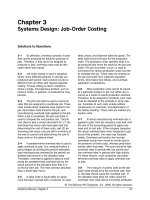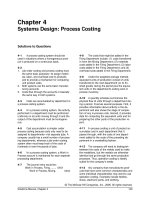Solutions to question managerial accounting ch15 servive department costing
Bạn đang xem bản rút gọn của tài liệu. Xem và tải ngay bản đầy đủ của tài liệu tại đây (108.83 KB, 39 trang )
Chapter 15
Service Department Costing:
An Activity Approach
Solutions to Questions
15-1 Operating departments are the units in
an organization within which the central purposes of the organization are carried out; these
departments usually generate revenue. By contrast, service departments provide support or
assistance to the operating departments. Examples of service departments include laundry services, internal auditing, airport maintenance services (ground crews), cafeteria, personnel, cost
accounting, and so on.
15-4 Under the direct method, costs are not
allocated from one service department to another. Rather, all service department costs are
allocated directly to operating departments.
15-2 Service department costs are allocated
to products and services in two stages. Service
department costs are first allocated to the operating departments. These allocated costs are
then included in the operating departments’
overhead rates, which are used to cost products
and services.
15-6 Two general guidelines govern the allocation of fixed service department costs to other
departments: (1) allocate only budgeted costs,
and (2) allocate fixed costs in predetermined,
lump-sum amounts, according to how much of
the service department’s capacity is acquired to
serve each of the other departments.
Two general guidelines also govern the
allocation of variable service department costs
to other departments: (1) allocate at budgeted
rates, and (2) allocate the costs according to
whatever activity (direct labor-hours, pounds of
laundry, etc.) causes their incurrence.
15-3 Interdepartmental service costs exist
whenever two service departments perform services for each other. Under the step method, the
costs of the service department performing the
greatest amount of service for the other service
departments are allocated first, the costs of the
service department performing the next greatest
amount of service are allocated next, and so
forth through all the service departments. Once
a service department’s costs have been allocated, costs are not reallocated back to it under
the step method.
15-5 If a service department generates revenues, these revenues should be offset against
the department’s costs and only the net amount
of cost remaining after this offset should be allocated to other departments.
15-7 If a variable base is used to allocate
fixed costs, the costs allocated to one department will depend in large part on what is happening in other departments. As a consequence,
the amount of service department cost allocated
to a department will increase or decrease depending on the activity in other departments.
© The McGraw-Hill Companies, Inc., 2006. All rights reserved.
Solutions Manual, Chapter 15
915
Exercise 15-1 (15 minutes)
Service Departments
AdminiFacility
stration
Services
Departmental costs before
allocations ...................... $2,400,000 $1,600,000
Allocations:
Administration costs
(20/25, 5/25).............. (2,400,000)
Facility Services costs
(70/100, 30/100)* ......
(1,600,000)
Total costs after allocation . $
0 $
0
Operating Departments
Undergraduate
Graduate
Programs
Programs
$26,800,000
$5,700,000
1,920,000
480,000
1,120,000
$29,840,000
480,000
$6,660,000
Total
$36,500,000
$36,500,000
*Based on the space occupied by the two operating departments, which is 100,000 square feet.
© The McGraw-Hill Companies, Inc., 2006. All rights reserved.
916
Managerial Accounting, 11th Edition
Exercise 15-2 (15 minutes)
Service
Departments
Administration Janitorial
Departmental costs before allocations ..... $150,000 $40,000
Allocations:
Administration costs
(160/4,000, 3,100/4,000,
740/4,000)* ................................... (150,000)
6,000
Janitorial costs
(4,000/5,000, 1,000/5,000)†............
(46,000)
Total costs after allocation ..................... $
0 $
0
Operating
Departments
Groceries
Gifts
$2,320,000 $950,000
116,250
Total
$3,460,000
27,750
36,800
9,200
$2,473,050 $986,950
$3,460,000
*Based on employee hours in the other three departments, 160 + 3,100 + 740 = 4,000.
†Based on space occupied by the two operating departments, 4,000 + 1,000 = 5,000.
Both the Janitorial Department costs of $40,000 and the Administration costs of $6,000 that have been
allocated to the Janitorial Department are allocated to the two operating departments.
© The McGraw-Hill Companies, Inc., 2006. All rights reserved.
Solutions Manual, Chapter 15
917
Exercise 15-3 (10 minutes)
Northern
Plant
Variable costs:
$0.25 per ton × 120,000 tons ........... $ 30,000
$0.25 per ton × 60,000 tons.............
Fixed costs:
70% × $300,000 ............................. 210,000
30% × $300,000 .............................
Total allocated costs ........................... $240,000
Southern
Plant
$ 15,000
90,000
$105,000
© The McGraw-Hill Companies, Inc., 2006. All rights reserved.
918
Managerial Accounting, 11th Edition
Exercise 15-4 (20 minutes)
1. and 2.
End-of-year allocations of variable costs should be based on the actual
level of activity multiplied by the budgeted rate. End-of-year allocations
of fixed costs should be based on the same predetermined lump-sum
amounts as at the beginning of the year. Actual costs in excess of (or
less than) the budgeted rate for variable costs or the budgeted total
fixed costs should not be allocated to the plants. Therefore, the allocations of transport services cost at the end of the year would be:
Variable costs:
$0.25 per ton × 130,000 tons...
$0.25 per ton × 50,000 tons ....
Fixed costs:
70% × $300,000 .....................
30% × $300,000 .....................
Total cost ..................................
Northern
Plant
$ 32,500
210,000
$242,500
Southern
Plant
Total
$ 12,500
$ 45,000
90,000
$102,500
300,000
$345,000
3. Part of the $364,000 in total cost will not be allocated to the plants, as
follows:
Total cost incurred......................
Total cost allocated (above) ........
Amount of cost not allocated.......
Variable
Cost
$54,000
45,000
$ 9,000
Fixed Cost
$310,000
300,000
$ 10,000
Total
$364,000
345,000
$ 19,000
The cost not allocated represents cost incurred in excess of the budgeted $0.25 per ton variable cost and budgeted $300,000 in fixed costs.
This $19,000 in unallocated cost is the responsibility of the Transport
Services Department and is a cost variance for the year.
© The McGraw-Hill Companies, Inc., 2006. All rights reserved.
Solutions Manual, Chapter 15
919
Exercise 15-5 (20 minutes)
Service
Departments
Administration
Janitorial
Operating
Departments
Maintenance
Binding
Printing
Total
Overhead costs .................................. $140,000 $105,000 $ 48,000 $275,000 $430,000 $998,000
Allocations:
Administration costs:
(5%, 20%, 45%, 30%)*................ (140,000)
7,000
28,000
63,000
42,000
Janitorial costs: (1/8, 2/8, 5/8) .........
(112,000) 14,000
28,000
70,000
Maintenance costs: (1/3, 2/3) ...........
(90,000)
30,000
60,000
Total overhead costs after allocations... $
0 $
0 $
0 $396,000 $602,000 $998,000
* Allocations can be shown in percentages, in fractions, or as a rate per unit of activity. For example,
Administration allocations have been shown as percentages, but they could have been shown as 1/20;
4/20; 9/20; and 6/20 or they could have been shown as $200 per employee. Fractions should be used
if percentages result in rounding errors.
© The McGraw-Hill Companies, Inc., 2006. All rights reserved.
920
Managerial Accounting, 11th Edition
Exercise 15-5 (continued)
Supporting computations:
Administration costs allocated on the basis of:
Janitorial..................
35 employees
5%
Maintenance ............
140 employees
20
Binding....................
315 employees
45
Printing ...................
210 employees
30
Total........................
700 employees
100 %
Janitorial costs allocated on the basis of:
Maintenance ............
20,000 square feet
Binding....................
40,000 square feet
Printing ................... 100,000 square feet
Total........................ 160,000 square feet
1/8
2/8
5/8
8/8
Maintenance costs allocated on the basis of:
Binding....................
30,000 hours
Printing ...................
60,000 hours
Total........................
90,000 hours
1/3
2/3
3/3
© The McGraw-Hill Companies, Inc., 2006. All rights reserved.
Solutions Manual, Chapter 15
921
Exercise 15-6 (20 minutes)
Service
Departments
Administration
Janitorial
Operating
Departments
Maintenance
Overhead costs ........................... $140,000 $105,000 $ 48,000
Allocation:
Administration costs: (3/5, 2/5) . (140,000)
Janitorial costs: (2/7, 5/7) .........
(105,000)
Maintenance costs: (1/3, 2/3) ....
(48,000)
Total overhead costs after allocations ........................................ $
0 $
0 $
0
Binding
$275,000
84,000
30,000
16,000
$405,000
Printing
Total
$430,000 $998,000
56,000
75,000
32,000
$593,000 $998,000
Supporting computations:
Binding..
Printing .
Total......
Administration
315 employees 3/5
210 employees 2/5
525 employees 5/5
Janitorial
40,000 square feet 2/7
100,000 square feet 5/7
140,000 square feet 7/7
Maintenance
30,000 hours 1/3
60,000 hours 2/3
90,000 hours 3/3
© The McGraw-Hill Companies, Inc., 2006. All rights reserved.
922
Managerial Accounting, 11th Edition
Exercise 15-7 (20 minutes)
1.
Percentage of 2005 sales.....................
Allocation of 2005 fixed administrative
expenses (based on the above
percentages)....................................
2. 2005 allocation (above) .......................
2004 allocation ...................................
Increase (decrease) in allocation ..........
Restaurants
Rick’s
Imperial
Harborside
Garden
32%
$640,000
50%
$1,000,000
$640,000 $1,000,000
800,000
750,000
$(160,000) $ 250,000
Ginger
Wok
18%
$360,000
Total
100%
$2,000,000
$360,000 $2,000,000
450,000
2,000,000
$(90,000) $
0
The manager of the Imperial Garden undoubtedly will be upset about the increased allocation of
fixed administrative expense. Such an increased allocation may be viewed as a penalty for an outstanding performance.
3. Sales dollars is not ordinarily a good base for allocating fixed costs. The departments with the greatest sales will be allocated the greatest amount of cost and the costs allocated to a department will be
affected by the sales in other departments. In our illustration above, the sales in two restaurants remained static and the sales in the third increased. As a result, less cost was allocated to the restaurants with static sales and more cost was allocated to the one restaurant that showed improvement
during the period.
© The McGraw-Hill Companies, Inc., 2006. All rights reserved.
Solutions Manual, Chapter 15
923
Exercise 15-8 (15 minutes)
The budgeted rate of $18 per X-ray should be multiplied by the actual
number of X-rays provided for each operating department for the end-ofyear allocations.
Pediatrics......................
OB Care .......................
General Hospital............
Total ............................
(2)
(1)
Actual
Budgeted Number of
Rate
X-rays
$18
$18
$18
6,000
3,000
15,000
24,000
(1) × (2)
Total
Allocation
$108,000
54,000
270,000
$432,000
The difference between the budgeted and actual cost per X-ray is the responsibility of the Radiology Department and is not allocated to the operating departments. This variance totals $48,000 for the year.
24,000 X-rays × ($20 – $18 = $2 per X-ray) = $48,000.
© The McGraw-Hill Companies, Inc., 2006. All rights reserved.
924
Managerial Accounting, 11th Edition
Exercise 15-9 (15 minutes)
1.
Cost to be allocated ............................
Allocations:
Janitorial Services:
(4%, 20%, 16%, 60%) ..................
Radiology: (3/10, 2/10, 5/10) ............
Total overhead costs after allocations ...
Janitorial
Services
$375,000
(375,000)
$
0
Radiology
$590,000
Pediatrics
15,000 $ 75,000
(605,000) 181,500
$
0 $256,500
OB Care
General
Hospital
$ 60,000 $225,000
121,000
302,500
$181,000 $527,500
Supporting computations:
Janitorial Services:
Radiology.............
Pediatrics .............
OB Care ...............
General Hospital ...
6,000
30,000
24,000
90,000
150,000
sq.
sq.
sq.
sq.
sq.
ft.
4%
ft. 20
ft. 16
ft. 60
ft. 100 %
Radiology:
Pediatrics ............
OB Care ..............
General Hospital ..
9,000
6,000
15,000
30,000
X-rays
3/10
X-rays
2/10
X-rays 5/10
X-rays 10/10
2. The allocations would be the same as in Part 1, since budgeted fixed costs are always allocated to
consuming departments. Thus, $6,000 of the actual fixed costs in Janitorial Services ($381,000 –
$375,000) and $10,000 of the actual fixed costs in Radiology ($600,000 – $590,000) would not be allocated to other departments.
© The McGraw-Hill Companies, Inc., 2006. All rights reserved.
Solutions Manual, Chapter 15
925
Problem 15-10 (60 minutes)
(Thousands of ¥)
1.
Step method
Factory
Administration
Custodial
Services Personnel
Maintenance
Machining Assembly
Operating department costs......
¥376,300 ¥175,900
Costs to be allocated ................ ¥270,000 ¥ 68,760 ¥ 28,840 ¥ 45,200
Allocations:
Factory Administration
@ ¥1,800 per labor-hour ..... (270,000)
5,400
9,000
39,600
54,000
162,000
Custodial Services
@ ¥720 per square foot.......
(74,160)
2,160
7,200
50,400
14,400
Personnel
@ ¥320,000 per employee...
(40,000)
8,000
12,800
19,200
Maintenance
@ ¥1,250 per machinehour ..................................
(100,000)
87,500
12,500
Total overhead after
allocations ............................ ¥
0 ¥
0 ¥
0 ¥
0 ¥581,000 ¥384,000
Divide by machine-hours
(thousands) ..........................
÷
70
Divide by direct labor-hours
(thousands) ..........................
÷
80
Overhead rate .........................
¥ 8,300 ¥ 4,800
© The McGraw-Hill Companies, Inc., 2006. All rights reserved.
926
Managerial Accounting, 11th Edition
Problem 15-10 (continued)
(Thousands of ¥)
2.
Direct method
Factory
Administration
Operating department costs......
Costs to be allocated ................ ¥270,000
Allocations:
Factory Administration
(1/4, 3/4) ........................... (270,000)
Custodial Services (7/9, 2/9) ..
Personnel (2/5, 3/5) ..............
Maintenance (7/8, 1/8) ..........
Total overhead after allocations..................................... ¥
0
Divide by machine-hours
(thousands) ..........................
Divide by direct labor-hours
(thousands) ..........................
Overhead rate..........................
Custodial
Services Personnel
¥68,760
(68,760)
¥
0
¥28,840
(28,840)
¥
0
Maintenance
¥45,200
(45,200)
¥
0
Machining Assembly
¥376,300
¥175,900
67,500
53,480
11,536
39,550
202,500
15,280
17,304
5,650
¥548,366
¥416,634
÷
70
÷ 80
¥ 7,834 ¥ 5,208
© The McGraw-Hill Companies, Inc., 2006. All rights reserved.
Solutions Manual, Chapter 15
927
Problem 15-10 (continued)
3. Plantwide rate
Overhead rate=
=
Total overhead cost
Total direct labor-hours
¥965,000,000
=¥9,650 per DLH
100,000 DLHs
4. The amount of overhead cost assigned to the job would be:
Step method:
Machining Department: ¥8,300 per machine-hour ×
190 machine-hours ................................................ ¥1,577,000
Assembly Department: ¥4,800 per direct labor-hour
× 75 direct labor-hours...........................................
360,000
Total overhead cost ..................................................... ¥1,937,000
Direct method:
Machining Department: ¥7,834 per machine-hour ×
190 machine-hours ................................................ ¥1,488,460
Assembly department: ¥5,208 per direct labor-hour ×
75 direct labor-hours ..............................................
390,600
Total overhead cost ..................................................... ¥1,879,060
Plantwide method:
¥9,650 per direct labor-hour × 100 direct labor-hours . ¥ 965,000
The plantwide method, which is based on direct-labor hours, assigns
very little overhead cost to the job since it requires little labor time. Assuming that Factory Administrative costs really do vary in proportion to
labor-hours, Custodial Services with square feet occupied, and so on,
the company will tend to undercost such jobs if a plantwide overhead
rate is used (and it will tend to overcost jobs requiring large amounts of
labor time). The direct method is better than the plantwide method, but
the step method will generally provide the most accurate overhead rates
of the three methods.
© The McGraw-Hill Companies, Inc., 2006. All rights reserved.
928
Managerial Accounting, 11th Edition
Problem 15-11 (45 minutes)
1.
Variable costs:
$3 per meal × 35,000 meals ....
$3 per meal × 20,000 meals ....
Fixed costs:
65% × $40,000.......................
35% × $40,000.......................
Total cost allocated ....................
Auto
Division
$105,000
26,000
$131,000
Truck
Division
$60,000
14,000
$74,000
The variable costs are allocated by multiplying the budgeted rate per
meal by the budgeted number of meals that will be served in each division during the month. The fixed costs are allocated in predetermined,
lump-sum amounts based on the peak-period need for meals in each division.
2.
Variable costs:
$3 per meal × 20,000 meals ....
$3 per meal × 20,000 meals ....
Fixed costs:
65% × $40,000.......................
35% × $40,000.......................
Total cost allocated ....................
Auto
Division
$60,000
26,000
$86,000
Truck
Division
$60,000
14,000
$74,000
The variable costs are allocated according to the budgeted rate per meal
and not according to the actual rate. The fixed costs are again allocated
in predetermined, lump-sum amounts, based on budgeted fixed costs.
Any difference between budgeted and actual costs is not allocated, but
rather is treated as a spending variance of the cafeteria:
Total actual costs for the month ...............
Total cost allocated above ........................
Spending variance—not allocated .............
Variable
$128,000
120,000
$ 8,000
Fixed
$42,000
40,000
$ 2,000
© The McGraw-Hill Companies, Inc., 2006. All rights reserved.
Solutions Manual, Chapter 15
929
Problem 15-11 (continued)
3. Actual variable costs..............
Actual fixed costs..................
Total actual costs ..................
$128,000
42,000
$170,000
One-half of the cost, or $85,000, would be allocated to each division,
since an equal number of meals were served in each division during the
month.
4. This method has two major problems. First, the spending variances
should not be allocated, since this forces the inefficiencies of the service
department onto the using departments. Second, the fixed costs should
not be allocated according to month-by-month usage of services, since
this causes the allocation to one division to be affected by what happens
in another division.
5. Their strategy probably will be to underestimate their peak period requirements in order to force a greater proportion of any allocation onto
other departments. Top management can control ploys of this type by
careful follow-up, with rewards being given to those managers who estimate accurately, and severe penalties assessed against those managers who underestimate their peak period requirements. For example,
departments whose managers underestimate their peak period requirements may be denied access to the cafeteria once their estimates have
been exceeded.
© The McGraw-Hill Companies, Inc., 2006. All rights reserved.
930
Managerial Accounting, 11th Edition
Problem 15-12 (30 minutes)
1. Yes, there is merit to the complaint. The company is using a variable
base (hours of hangar use) to allocate costs that are largely fixed. Thus,
the amount of cost that is charged to a division during a given month
will depend to a large extent on usage in other divisions. A reduction in
usage in one division can result in shifts of costs from it onto the other
divisions, even though the other divisions receive no more service.
2.
1st quarter activity ................
2nd quarter activity ...............
Difference ............................
Variable cost element =
=
Hours of Use
3,000
2,000
1,000
Total Cost
$172,000
168,000
$ 4,000
Change in cost
Change in activity
$4,000
=$4 per hour
1,000 hours
Fixed cost per quarter:
Total cost, 1st quarter................................................
Less variable cost ($4 per hour × 3,000 hours)............
Fixed cost .................................................................
$172,000
12,000
$160,000
Thus, the cost formula is $160,000 fixed cost plus $4 per hour variable
cost.
© The McGraw-Hill Companies, Inc., 2006. All rights reserved.
Solutions Manual, Chapter 15
931
Problem 15-12 (continued)
3. Even though the peak-period level of activity will not be reached until
the fourth quarter, it should still be used to allocate the fixed costs of
the hangar. The reason is that peak-period requirements determine the
present level of fixed costs. The fact that the divisions do not need a
peak-period level of servicing every quarter is immaterial. If the divisions
require such servicing at certain times, then the capacity to deliver it
must be available, and it is the responsibility of the divisions to bear the
cost of that capacity.
1st quarter allocation:
Variable cost:
$4 per hour × 900 hours .................
$4 per hour × 1,800 hours ..............
$4 per hour × 300 hours .................
Domestic Overseas
Freight Passenger Passenger
$ 3,600
Fixed cost:
30% × $160,000 ............................ 48,000
50% × $160,000 ............................
20% × $160,000 ............................
Total cost allocation ........................... $51,600
2nd quarter allocation:
Variable cost:
$4 per hour × 800 hours .................
$4 per hour × 700 hours .................
$4 per hour × 500 hours .................
$ 3,200
Fixed cost:
30% × $160,000 ............................ 48,000
50% × $160,000 ............................
20% × $160,000 ............................
Total cost allocation ........................... $51,200
$ 7,200
80,000
$87,200
$ 2,800
80,000
$82,800
$ 1,200
32,000
$33,200
$ 2,000
32,000
$34,000
© The McGraw-Hill Companies, Inc., 2006. All rights reserved.
932
Managerial Accounting, 11th Edition
Problem 15-13 (45 minutes)
Housekeeping
Services
Variable costs.............................. $
0 $193,860 $158,840
Food Services allocation:
$2.70 per meal × 800 meals ......
$2.70 per meal × 2,000 meals ...
$2.70 per meal × 1,000 meals ...
$2.70 per meal × 68,000 meals .
Admin. Services allocation:
$3.50 per file × 14,000 files ......
$3.50 per file × 7,000 files ........
$3.50 per file × 25,000 files ......
Total variable costs ...................... $
Food
Services
Administrative
Services Laboratory Radiology
(2,160)
(5,400)
(2,700)
(183,600)
0
$
2,160
$243,600
5,400
(49,000)
49,000
(24,500)
(87,500)
0 $
0 $298,000
General
Hospital
$304,800 $ 74,500
2,700
183,600
24,500
87,500
$332,000 $345,600
© The McGraw-Hill Companies, Inc., 2006. All rights reserved.
Solutions Manual, Chapter 15
933
Problem 15-13 (continued)
Housekeeping
Services
Fixed costs.................................. $87,000
Food
Services
$107,200
Housekeeping Services allocation
@ $0.60 per square foot:
$0.60 × 13,000 square feet .......
(7,800)
$0.60 × 6,500 square feet......... (3,900)
$0.60 × 10,000 square feet ....... (6,000)
$0.60 × 7,500 square feet ......... (4,500)
$0.60 × 108,000 square feet ..... (64,800)
Food Services allocation:
0.8% × $115,000...................
2.4% × $115,000...................
1.6% × $115,000...................
95.2% × $115,000 ..................
Administrative
Services Laboratory Radiology
$90,180
7,800
3,900
(920)
(2,760)
(1,840)
(109,480)
Admin. Services allocation:
30% × $95,000 .......................
20% × $95,000 .......................
50% × $95,000 .......................
920
(28,500)
(19,000)
(47,500)
$162,300
General
Hospital
$215,700 $401,300
6,000
2,760
28,500
4,500
1,840
19,000
64,800
109,480
47,500
Total fixed costs .......................... $
0
$
0
$
0
$199,560
$241,040 $623,080
Total overhead costs.................... $
0
$
0
$
0
$497,560
$573,040 $968,680
© The McGraw-Hill Companies, Inc., 2006. All rights reserved.
934
Managerial Accounting, 11th Edition
Problem 15-13 (continued)
Computation of allocation rates:
Variable Food Services:
Allocation rate=
=
Variable food services costs
Meals served
$193,860
71,800 meals
=$2.70 per meal
Variable Administrative Services:
Allocation rate=
=
Variable administrative services costs
Files processed
$158,840 + $2,160
46,000 files
=$3.50 per file
Fixed Housekeeping Services:
Allocation rate=
=
Fixed housekeeping services costs
Square feet
$87,000
150,000 square feet - 5,000 square feet
=$0.60 per square foot
© The McGraw-Hill Companies, Inc., 2006. All rights reserved.
Solutions Manual, Chapter 15
935
Problem 15-14 (30 minutes)
1. Beginning-of-year allocations of variable costs are computed by multiplying the budgeted rate by the budgeted level of activity. Fixed costs are
allocated in lump-sum amounts based on the peak-period needs of the
using departments. The computations are:
Variable costs:
$0.40 per machine-hour ×
160,000 machine-hours .......
$0.40 per machine-hour ×
80,000 machine-hours.........
Fixed costs:
70% × $150,000 ...................
30% × $150,000 ...................
Total cost allocated...................
Forming
Assembly
Department Department
Total
$ 64,000
105,000
$169,000
$32,000
$ 96,000
45,000
$77,000
150,000
$246,000
2. a. End-of-year allocations of variable costs are computed by multiplying
the budgeted rate by the actual level of activity. Fixed costs are again
allocated in predetermined lump-sum amounts based on budgeted
costs. The computations are:
Variable costs:
$0.40 per machine-hour ×
190,000 machine-hours .......
$0.40 per machine-hour ×
70,000 machine-hours.........
Fixed costs:
70% × $150,000 ...................
30% × $150,000 ...................
Total cost allocated...................
Forming
Assembly
Department Department
Total
$ 76,000
105,000
$181,000
$28,000
$104,000
45,000
$73,000
150,000
$254,000
© The McGraw-Hill Companies, Inc., 2006. All rights reserved.
936
Managerial Accounting, 11th Edition
Problem 15-14 (continued)
b. Any difference between the budgeted and actual variable cost per
machine-hour or between the budgeted and actual total fixed cost
would not be allocated to the other departments. The amount not allocated would be:
Variable
Cost
Fixed
Cost
Total
Actual cost incurred during the year ... $110,000 $153,000 $263,000
Cost allocated (above) ....................... 104,000 150,000 254,000
Cost not allocated (spending
variance) ....................................... $ 6,000 $ 3,000 $ 9,000
The costs not allocated are spending variances of the Maintenance
Department and are the responsibility of the Maintenance Department’s manager.
© The McGraw-Hill Companies, Inc., 2006. All rights reserved.
Solutions Manual, Chapter 15
937
Problem 15-15 (60 minutes)
1. and 2.
Variable costs to be allocated .....................
Building & AdminiGrounds stration
R
0
Administration:
R20 per employee × 30 employees ..........
R20 per employee × 450 employees ........
R20 per employee × 630 employees ........
R22,200 R16,900
(600)
(9,000)
(12,600)
Equipment maintenance:
R0.10 per MH × 70,000 MHs ...................
R0.10 per MH × 105,000 MHs..................
Totals .......................................................
Equipment
Maintenance
600
(7,000)
(10,500)
R
0
R
0
R
0
Fabrication
R 9,000
7,000
R16,000
Finishing
R12,600
10,500
R23,100
© The McGraw-Hill Companies, Inc., 2006. All rights reserved.
938
Managerial Accounting, 11th Edition
Problem 15-15 (continued)
Fixed costs to be allocated .....................
Building & Grounds:
R3 per sq. ft. × 500 sq. ft....................
R3 per sq. ft. × 1,400 sq. ft. ................
R3 per sq. ft. × 12,000 sq. ft. ..............
R3 per sq. ft. × 15,500 sq. ft. ..............
Building & AdminiGrounds stration
R88,200 R60,000
(1,500)
(4,200)
(36,000)
(46,500)
Administration:
3% × R61,500 .................................
38% × R61,500..................................
59% × R61,500..................................
Equipment Maintenance:
40% × R30,045..................................
60% × R30,045..................................
Total fixed costs ....................................
Total allocated costs ..............................
Other budgeted costs ............................
Total overhead costs (a).........................
Budgeted machine-hours (b) ..................
Predetermined overhead rate (a) ÷ (b) ...
Equipment
Maintenance
R24,000
1,500
4,200
(1,845)
(23,370)
(36,285)
1,845
Fabrication
R36,000
23,370
R
0
R
0
(12,018)
12,018
(18,027)
R
0
R 71,388
R
0
R
0
R
0
R 87,388
566,000
R653,388
70,000
R9.33
Finishing
R46,500
36,285
18,027
R100,812
R123,912
810,000
R933,912
105,000
R8.89
© The McGraw-Hill Companies, Inc., 2006. All rights reserved.
Solutions Manual, Chapter 15
939









